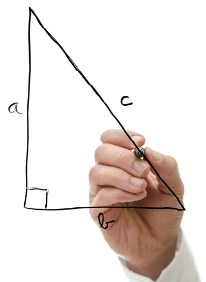


Welcome to the fascinating world of the Law of Cosines, a fundamental trigonometric concept that plays a crucial role in solving triangles. The Law of Cosines is an essential tool for understanding and calculating the relationships between the sides and angles of non-right triangles. Unlike the Law of Sines, which is primarily used for solving triangles with known angles, the Law of Cosines is versatile and can be applied to a wider range of scenarios.
The Law of Cosines formula is the cornerstone of this trigonometric concept. It states that in any triangle, the square of one side is equal to the sum of the squares of the other two sides minus
twice the product of those two sides and the cosine of the included angle.
Mathematically, it can be expressed as c² = a² + b² - 2ab * cos(C), where 'c' is the side opposite angle 'C,' 'a' and
'b' are the other two sides, and 'C' is the included angle.
Suppose you have a triangle with all three angles known, but you need to find the length of one of its sides.
The Law of Cosines can be your go-to method.
To solve for a side, rearrange the formula as 'c = √(a² + b² - 2ab * cos(C))' and plug in the values you know.
Let's say you have sides 'a' and 'b' and angle 'C,' simply substitute them into the equation, and you'll find the length of side 'c.'
Suppose you have a simple pendulum with a length (L) of 1 meter and you want to find its period (T).
Use the Law of Cosines formula:
c = √(a² + b² - 2ab * cos(C))
c = √(5² + 7² - 2 * 5 * 7 * cos(60°))
c ≈ √39 ≈ 6.24 units
So, the length of side 'c' is approximately 6.24 units.
Conversely, if you have all three sides of a triangle but need to find one of its angles, the Law of Cosines can still
come to your rescue.
To find an angle, rearrange the formula as 'cos(C) = (a² + b² - c²) / (2ab)' and then use the arccosine function (cos⁻¹)
to isolate angle 'C.'
This process will provide you with the measure of the desired angle.
Use the Law of Cosines rearranged for finding angles:
cos(C) = (a² + b² - c²) / (2ab)
Plug in the values:
cos(C) = (5² + 7² - 6.24²) / (2 * 5 * 7)
Calculate:
C ≈ cos⁻¹(0.5003) ≈ 60.03 degrees
So, the measure of angle 'C' is approximately 60.03 degrees.

In some cases, using the Law of Cosines may lead to ambiguous results. This happens when the equation yields multiple possible solutions or no solutions at all. The ambiguous case typically arises when you're trying to solve for an angle, and it's crucial to recognize and handle these situations correctly.
The Law of Cosines finds application in various fields, including navigation, engineering, and physics. For instance, it's used in geodesy to measure distances on the Earth's surface, in astronomy to calculate the distance between celestial objects, and in architecture to determine the lengths of trusses and structural components.
While both the Law of Cosines and the Law of Sines are essential tools in trigonometry, they serve different purposes. The Law of Cosines is best suited for solving triangles when you know all three sides or two sides and the included angle. In contrast, the Law of Sines is more appropriate when you have information about angles and their corresponding opposite sides. Understanding when to apply each law is key to solving a wide range of trigonometric problems.
If you've ever wondered how mathematicians arrived at the Law of Cosines, let's provide a straightforward derivation. Consider a triangle with sides 'a,' 'b,' and 'c' and angle 'C' opposite side 'c.' By dropping a perpendicular from angle 'C' to side 'a,' you can create a right triangle. Using the Pythagorean Theorem, you can derive the Law of Cosines from this right triangle, providing a deeper understanding of its origins.
h = c * sin(C) - Express 'h' in terms of 'c' and 'b
a² = b² + c² * sin²(C) - Substitute 'h' back into the Pythagorean Theorem
sin²(C) = 1 - cos²(C) - Apply the trigonometric identity:
a² = b² + c² * (1 - cos²(C))
cos²(C) = (a² + b² - c²) / (2ab) -Rearrange the equation to derive the Law of Cosines for angles
For those looking to delve deeper into the Law of Cosines, there are advanced topics to explore. These include adapting the Law of Cosines for non-right triangles, spherical trigonometry, and its applications in geodesy, seismology, and more. These advanced concepts showcase the versatility and importance of the Law of Cosines in various fields.
It's a formula to solve triangles, especially when you have side lengths and angles.
Use it when you have enough side and angle information in a triangle.
Law of Cosines for sides; Law of Sines for angles.
Yes, but it simplifies to the Pythagorean Theorem.
Multiple solutions or none; context matters.
Rearrange: cos(C) = (a² + b² - c²) / (2ab)
Yes, adapted for spherical problems.
Navigation, engineering, physics, astronomy, etc.
Create a right triangle, apply Pythagoras, use trig identities.
Best for SSS, SAS, or SSA triangles; check results for validity.



















































































































































